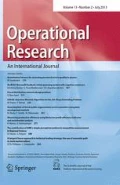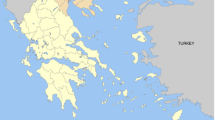Abstract
In this paper, a nonlinear model to maximize biomass production with specific nutritional quality is proposed. The model decides about kind of grasses and legumes to cultivate, quantities of each grasses and legumes chosen, the use of resources, and the proper time of harvest at which the biomass with specific nutritional quality is maximized. Model works with sufficient information about biomass yield, nutrient content, water requirements and fertilizer requirements of several crops, and it can explore all possible harvest times and choose the right time in which biomass production is maximized with desired nutritional quality. Furthermore, the solution gives to the producers additional information on weekly irrigation plan and weekly fertilizers plan for m2 of cultivated grass. The model was tested on six scenarios using GAMS and obtained solutions are the global solution in each scenario.
Similar content being viewed by others
References
Alexander DL, Morel PC, Wood GR (2006) Feedding strategies for maximising gross margin in pig production. Glob Optim Sci Eng Case Stud 3(1):14–20
Aderson A, Earle M (1983) Diet planning in the third world by linear and goal programming. J Oper Res Soc 34:9–16
Agrell PJ, Stam A, Fischer G (2004) Interactive multiobjective agro-ecological land use planning: the Bungoma region in Kenya. Eur J Oper Res OR Appl 158:194–217
Berroterán J (2000) Modelo de utilización Cereal-pasto en sistemas de Producción de Sabanas Bien Drenadas con suelos Ácidos en Venezuela. Interciencia 25(4):203–209
Cab F, Enriquez J, Pérez J, Hernádez A, Herrera J, Ortega E, Quero A (2008) Potencial productivo de tres especies de Brachiaria en monocultivo y asociadas con Arachis Pintoi en Isla, Veracruz. Técnica Pecuaria en México 46(003):317–332
Chappel AE (1974) Linear programming cuts costs in production of animal feeds. Oper Res Q 25(1):19–26
Cortés ME, Sánchez TM (2008) Modelo lineal multiobjetivo para la toma de decisiones en alimentación del ganado. Revis Investig Oper 29(1):5–9
El Sayed Abdel Asís MH (2007) Parametric and multiobjective optimisation applied in agriculture: the study of cropping pattern in the Ameriya region in winter crops. Revis Investig Oper 28(1):17–24
Frederiksen J, Kategile J (1980) The effect of nitrogen fertilization and time of cutting in first growth in Brachiaria Brizantha on yield, crude protein content and in vitro digestibility. Trop Anim Prod 5(2):136–143
Generic Algebraic Modelling Systems Development Corporation (2008). Generic Algebraic Modelling Systems V. 22.9.2. GAMS Development Corporation, Washington, DC
García A, Rodríguez JJ, Ruiz DM (1998) Optimización del engorde de bovinos en pastoreo en la Pampa Argentina mediante programación lineal. Invest Agrar Prod Sanid Anim 13(1, 2 y 3):99–117
García B, Vilario D, Fogueroa V, López O, Piloto J (1998) Modelo matemático de optimización para granjas integrales de agricultura sostenible. Revis Comput Investig Porcina 5(1):55–67
Garg MR (2012) Balanced feeding for improving livestock productivity—increase in milk production and nutrient use efficiency and decrease in methane emission, FAO Animal Production and Health Paper, No. 173, Rome, Italy
Gervásio de Oliveira J, Batista J, Barioni L, Gonçalves G, Braga A, Espellet M (2010) Optimized feed planning for a grazing horse production systems. Revis Bras Zootec 39(4):932–940
Glen JJ (1974) A Linear programming model for an integrated crop and intensive beef production enterprise. J Oper Res Soc 37(5):487–494
Glover F (1975) Improved linear integer programming formulations of nonlinear integer problems. Manag Sci 22(4):455–460
González I, Betancourt A, Fuenmayor A, Lugo M (2011) Producción y composición química de forrajes de dos especies de pasto Elefante (Pennisetum sp.) en el Noroccidente de Venezuela. Zootec Trop 29(1):103–112
Grof B, Harding W (1970) Dry matter yields and animal production of Guinea grass (panicum maximun) on the humid tropical Coast of North Queensland. Trop Grassl 40(1):85–95
Grossmann I, Viswanathan J, Vecchieti A, Raman R, Kalvelagen E. DICOPT (2008) General Algebraic Modelling Systems GAMS Developtment Corporation, Washington, D.C
Guenni O, Gil J, Baruch Z, Mrquez L, Nuez C (2006) Respuestas al déficit hídrico en especies forrajeras de Brachiaria (TRIN.) GRISEB. (POACEAE). Interciencia 31(007):505–511
Holman F (2002) El uso de modelos de simulación como herramienta para la toma de decisiones en la promoción de nuevas alternativas forrajeras: el caso de Costa Rica y Perú. Archivos Latinoamericanos de Producción Animal 10(1):35–45
Jena S, Poggi M (2013) Harvest planning in the Brazilian sugar cane industry via mixed integer programming. Eur J Oper Res Innov Appl OR 230:374–384
Johnson C, Reiling B, Mislevy P, Hall M (2001) Effects of nitrogen fertilization and harvest date on yield, digestibility, fiber, and protein fractions of tropical grasses. J Anim Sci 79:2439–2448
Juárez F, Fox D, Blake R (1999) Evaluation of tropical grasses for milk production by dual-purpose cows in tropical mexico. J Dairy Sci 82:2136–2145
Júdez L, de Miguel M, Mas J, Bru R (2002) Modeling crop regional production using positive mathematical programming. Math Comput Model 35:77–86
Martínez D, Hernádez A, Enríquez J, Pérez J, González S, Herrera J (2008) Producción de forraje y componentes del Rendimiento del Pasto Brachiaria Humidicola Ciat 6133 con diferente manejo de la defoliación. Técnica Pecuaria en México 46(004):427–438
Hj Mohamad N, Said F (2011) A mathematical programming approach to crop mix problem. Técnica Pecuaria en México 46(004):427–438
Munford A (1996) The use of iterative linear programming in practical applications of animal diet formulation. Afr J Agric Res 6(1):191–197
Oladokun VO, Johnson A (2012) Feed formulation problem in nigerian poultry farms: a mathematical programming approach. Am J Sci Ind Res 3(1):14–20
Olivera Y, Machado R, Del Pozo P, Ramírez J, Cepero B (2007) Evaluación de accesiones de Brachiria brizanta en suelos ácidos. Época de máximas precipitaciones, Pastos y Forrajes 30(3):303–313
Peralta J, Carrillo S, Hernández H, Porfirio N (2007) Características morfológicas y productivas, en etapa de producción, para ocho gramíneas forrajeras tropicales. APPA-ALPA-Cusco, Cusco
Pérez J, García E, Enríquez J, Quero R, Pérez J, Hernández A (2004) Análisis de crecimiento, área foliar específica y concentración de nitrógeno en hojas de pasto “mulato”(Brachiaria hbrido, cv.). Técnica Pecuaria en México 42(003):447–458
Prišenk J, Turk J, Rozman Č, Borec A, Zrakić M, Pažek K (2014) Advantages of combining linear programming and weighted goal programming for agriculture application. Oper Res Int J 14(2):253–260
Rehman T, Romero C (1987) Goal programming with penalty functions and livestock ration formulation. Agric Syst 23:117–132
Rosenthal R (2008) GAMS. A User’s guide. GAMS Development Corporation, Washington, DC
Saxena P (2011) Comparision of linear and nonlinear programming techiniques for animal diet. Appl Math 1(2):106–108
Saxena P Pathak (2011) Application of nonlinear programming for optimization of nutrient requirements for maximum weight gain in buffaloes. Int J Food Sci Nutr Eng 1(1):8–10
Saxena P, Pathak V, Kumar V (2012) Programming techinique for animal diet formulation: a non-linear approach. Int J Food Sci Nutr Eng 2(5):85–88
Sevilla G, Pasinato A, García J (2001) Curvas de crecimiento de forrajeras templadas irrigadas. Archivos Latinoamericanos de Produccin Animal 9(2):91–98
Tedeschi LO, Fox DG, Sainz RD, Barioni LG, Raposo de Medeiros S, Boin C (2005) Mathematical models in ruminant nutrition. Sci Agric 62(1):76–91
Vassalos M, Dillon D, Freshwater D, Karanikolas P (2010) Modeling multifunctionality of agriculture at a farm-level: The case of Kerkini District, Northern Greece, Applied Studies in Agribusiness and Commerce. Budapest (3–4):59–64
Waugh FV (1951) The minimum-cost dairy feed. J Farm Econ 33:299–310
Westerlund T, Lastusilta T. Alpha ECT (2008) General Algebraic Modelling Systems GAMS Development Corporation, Washington, D.C
Žgajnar J, Juvančič L, Kavčič S (2009) Combination of linear and weighted goal pragramming with penalty function in optimisation of a daily cow ration. Agric Econ 55(10):492–500
Acknowledgements
The work was supported by CDCHT-UCLA-Venezuela under the project 002-DAG-2012.
Author information
Authors and Affiliations
Corresponding author
Rights and permissions
About this article
Cite this article
Contreras, J., Lara, H. & Nouel-Borges, G. A mixed integer nonlinear programming model for biomass production. Oper Res Int J 19, 39–57 (2019). https://doi.org/10.1007/s12351-016-0283-4
Received:
Revised:
Accepted:
Published:
Issue Date:
DOI: https://doi.org/10.1007/s12351-016-0283-4




